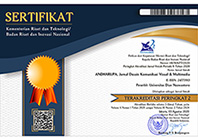Suasana Batin sebagai Pendukung Kreasi Gambar Ilustrasi pada Mahasiswa Program Studi Desain Komunikasi Visual Universitas Sebelas Maret
Abstract
Abstrak
Dalam ilmu desain, ekspresi berupa karya visual atau simbol terpengaruh suasana batin. Karya visual ini dapat diwujudkan menjadi suatu kreasi gambar ilustrasi. Kajian psikologi desain dengan fokus pada suasana batin sebagai pendukung kreasi gambar ilustrasi ini mempunyai dua tujuan yaitu: (1) mendeskripsikan dan menjelaskan suasana batin yang mendukung proses kreasi gambar ilustrasi; dan (2) mendeskripsikan dan menjelaskan wujud kreasi gambar ilustrasi atas pengaruh suasana batin. Metode yang digunakan dalam riset ini adalah metode kualitatif deskriptif, dengan strategi studi kasus. Studi kasus dengan setting penelitian pada mahasiswa peserta Mata Kuliah Pengantar Seni Rupa dan Desain Program Studi Desain Komunikasi Visual Universitas Sebelas Maret. Sampling menggunakan teknik purposive dan pemerolehan data melalui teknik dokumentasi, wawancara mendalam, dan instrumen. Validitas data menggunakan triangulasi teori, dan analisis menggunakan teknik analisis isi. Penelitian mendapatkan hasil: (1) suasana batin yang mendukung proses kreasi gambar ilustrasi pada mahasiswa Program Studi Desain Komunikasi Visual meliputi suasana batin kebingungan; sedih/tertekan/takut; dan optimis. (2) wujud kreasi gambar ilustrasi atas pengaruh suasana batin mahasiswa direpresentasikan berupa bentuk, garis, warna, ukuran, tekstur, ruang, dan arah. Namun yang dominan adalah bentuk, warna, dan tekstur.
Kata Kunci: gambar ilustrasi, proses kreasi, psikologi desain, suasana batin
Abstract
In design, expression in the form of visual works or symbols was influenced by inner mood. This visual work can be manifested into an illustration image creation. The study of psychological design with a focus on the inner atmosphere as a support for the creation of this illustration image has two objectives, namely: (1) to describe and explain the inner atmosphere that supports the process of creating illustration images; and (2) describe and explain the form of illustration image creation on the influence of inner mood. In this research, the descriptive-qualitative method was used with a case study strategy. The study took place in the "Introduction to Art and Design" course in the Visual Communication Design Department, Sebelas Maret University. Sampling uses purposive techniques and data collection through documentation techniques, in-depth interviews, and instruments. The validity of the data used theoretical triangulation, and the analysis used content analysis techniques. The result of this research is (1) a mental atmosphere that supports the process of creating illustration images for students of the Visual Communication Design department, which includes an inner mood of confusion; sadness/depression/fear; and optimism. (2) the form of illustration image creation on the influence of the students' inner atmosphere is represented in the form of shapes, lines, colors, sizes, textures, spaces, and directions. However, what is dominant is the shape, color, and texture.
Keywords: creation process, design psychology, illustration, inner mood
Full Text:
PDFReferences
Ambrose, S. A. (2010). How Learning Works: Research-Based Principles for Smart Teaching. San Francisco: Jossey Bass.
Anderman, E.M., dan A. L. (2010). Classroom Motivation. Columbus. Campbell: Pearson Education Inc.
Arnold, J. (2005). Work Psychology Understanding Human Behaviour in the Workplace. Harlow: Prentice Hall Publ.
Creswell, J. W. (2014). Research Design Qualitative, Quantitative, and Mixed Method. New Delhi: Sage India Pvt.
Faragasso, J. (1980). Mastering Drawing The Human Figure From Life, Memory, Imagination. Arizona: North Light Publ.
Firdaus, W., & Arjanggi, R. (2020). Self-efficacy and career decision making difficulties in senior high school students. Indigenous: Jurnal Ilmiah Psikologi, 5(2), 141–150.
Gilang, L., Sihombing, R. M., & Sari, N. (2018). Pengaruh Konteks pada Ilustrasi Buku Pendidikan Karakter terhadap Perilaku Disiplin Anak Usia Dini. Scholaria: Jurnal Pendidikan Dan Kebudayaan, 8(1), 41–50.
Maharsi, I. (2011). Komik: Dunia Kreatif Tanpa Batas (p. 92). Yogyakarta: Penerbit Kata Buku.
Merriam, S. B. (2009). Qualitative Research A Guide To Design And Implementation. San Francisco: John Wiley & Sons Inc.
Maulina R. (2012). Proses Kreasi Seorang Desainer Grafis (Studi Kasus : Stefan Sagmeister). Visualita, 4(1), 66-86.
Pradana, A. P., & Masnuna, M. (2021). Ilustrasi Buku Ensiklopedia Burung Rangkong Di Indonesia. ANDHARUPA: Jurnal Desain Komunikasi Visual & Multimedia, 7(01), 28–43.
Purba, B. (2021). Seni Lukis Kontemporer?: Ruang Misteri Anjani. Jurnal Ekspresi Seni Jurnal Ilmu Pengetahuan Dan Karya Seni, 23(1), 1–9.
Rahmawati, A. (2014). Pembelajaran Menggambar Ilustrasi Kartun Siswa Kelas Viii E Smp Negeri 1 Keling Kecamatan Keling Kabupaten Jepara. Journal of Visual Arts, 3(1), 45–53.
Resnick, E. (2003). Design for Communication: Conceptual Graphic Design Basics. New Jersey: John Wiley & Sons Inc.
Robson, D. (2018). This Phenomenon is Known as Cognitive Fixation, and Many Psychologists Now Consider It to be the Principle Barrier to True Creativity. New York: Taylor & Francis,LLC.
Samara, T. (2015). Drawing for Graphic Design Understanding Conceptual Principles and Practical Techniques to Create Unique, Effective Design Solutions. Beverly Hills: Rockpapare ink Publisher.
Smith, S. T. (2011). The User’s Guide to the Human Mind Why Our Brains Make Us Unhappy, Anxious, and Neurotic and What We Can Do about It. Oackland Avenue: New Harbinger Publications, Inc.
Tracy, S. J. (2013). Qualitative Research Methods. USD: Blackwell Publishing.
Wulandari, C. C., & Arumsari, R. Y. (2017). Perancangan Buku Ilustrasi Tembang Dolanan Jawa Tengah. Andharupa:?: Jurnal Desain Komunikasi Visual & Multimedia., 03(01), 49–58.
Yin, R. K. (2003). Qualitative Research?: from start to finish. London: The Guilford Press.
DOI: https://doi.org/10.33633/andharupa.v7i2.4616
Article Metrics
Abstract view : 427 timesPDF - 507 times
Refbacks
- There are currently no refbacks.
indexed by:
Andharupa Journal (p-ISSN: 2477 - 2852 | e-ISSN: 2477 - 3913) is published by Dian Nuswantoro University, Semarang. This Journal is licensed under Creative Commons Attribution 4.0 International License.
























